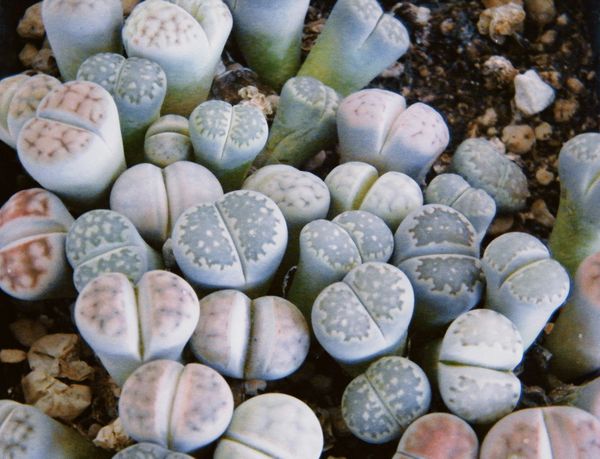Living Stones Care Guide
How to grow and care for Living Stones (Lithops spp.)
Lithops spp., commonly known as Living Stones, are fascinating succulents that resemble pebbles. These unique plants originate from the deserts of southern Africa, where their natural camouflage helps them blend into rocky environments. Indoor gardeners are increasingly drawn to Lithops for their striking appearance and minimal care requirements. When provided with the right conditions, these quirky and charming plants make a resilient addition to your indoor garden.

Disclosure: This content includes affiliate links, which means we may earn a commission if you click on a link and make a purchase. As an Amazon Associate, we earn from qualifying purchases. This comes at no extra cost to you and helps offset the cost of running Leafwise. Please read our disclaimer for more info.
Table of Contents
Care
Light
Living Stones thrive in bright, direct light for at least 4–5 hours per day, particularly in the morning. Partial shade—such as sheer curtains or placement behind a lightly shaded window—is recommended during intense afternoon hours to prevent scorching. Without sufficient sunlight, Lithops may stretch, become elongated, or lose their characteristic patterns. An east- or south-facing window is typically ideal.
Watering
Lithops have a unique and seasonal watering cycle. Begin watering in late summer or early fall when the old leaf pair starts to wrinkle and a new pair begins to emerge. During this growth period, water sparingly and only when the soil is completely dry. Cease watering in winter, as the plant enters dormancy. Do not resume watering until the old outer leaves have dried up and been fully replaced by the new pair, typically by late spring or early summer. In summary, Lithops require light watering only during active growth in fall and early winter and should remain dry throughout late winter and spring.
Humidity and Temperature
These succulents prefer dry air and low humidity. They grow best in temperatures ranging from 65–80°F (18–27°C) and should be kept above 50°F (10°C). Avoid exposing them to frost or excessively moist environments.
Soil
Use a gritty, fast-draining soil mix. A recommended blend includes 2 parts cactus soil to 1 part coarse sand or pumice. This allows water to drain quickly and prevents root rot. Choose shallow pots that are 3–5 inches deep and always include drainage holes. When planting, ensure the top of the leaves is level with the soil surface to mimic their natural growing habit and reduce the risk of rot.
Fertilization
Fertilize very sparingly. One application of diluted cactus fertilizer in the fall is sufficient for the year. Over-fertilization can lead to leggy or unhealthy growth.
Maintenance
Cleaning
Dust can accumulate on the surface of the leaves. Use a soft brush or cloth to gently clean them and maintain both their appearance and health.
Repotting
Lithops grow slowly and only require repotting every 3–4 years. When repotting, use fresh, gritty soil and a shallow pot with good drainage. Plant Lithops so that their leaf tops sit just above the soil line. Be cautious while handling to avoid damaging the delicate roots.
Propagation
By Seed
Seeds can be collected from mature Lithops plants after flowering and seed capsule development. Once the capsules have dried, gently break them open to release the seeds.
- Sow seeds on the surface of moist, well-draining soil.
- Lightly cover with a thin layer of sand.
- Place in a warm, bright location with indirect light.
- Maintain consistent light moisture, ideally through misting.
- Germination may take several weeks. Keep seedlings in a humid environment and be patient, as Lithops develop slowly.
By Division
- During repotting, gently separate any offsets that have formed.
- Ensure each division has roots attached.
- Allow cut surfaces to dry for a day or two.
- Replant in dry, well-draining soil and avoid watering for several days.
Common Issues
Root Rot
- Symptoms: Mushy, discolored roots; leaf collapse or splitting.
- Causes: Overwatering, poor drainage, or watering during dormancy.
- Solution: Remove the plant, trim affected roots, and repot in dry, gritty soil. Reduce or eliminate watering when dormant.
Yellowing or Splitting Leaves
- Symptoms: Yellowed or split leaves.
- Causes: Overwatering or a sudden surge of water after drought.
- Solution: Reduce watering and follow the seasonal watering guidelines.
Pests
- Symptoms: Signs of infestation may include white, cotton-like clusters from mealybugs, brown scale insects appearing as hard bumps, or webbing from spider mites. You may also notice small pits, scarring, or deformities on the leaf surface and slowed plant growth.
- Causes: Pests often thrive in warm, dry indoor environments and can spread from nearby infected plants.
- Solution: Inspect your Lithops regularly, especially between leaf fissures. Remove pests with a cotton swab dipped in rubbing alcohol, and isolate the affected plant. For larger infestations, apply a gentle insecticidal soap or neem oil, repeating treatment every 7–10 days until pests are eradicated.
